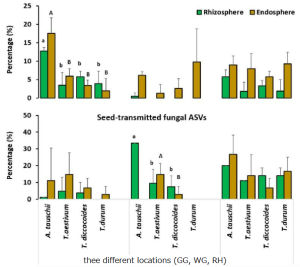A group from Institute of Applied Microbiology, Justus-Liebig-University, Giessen, Germany, etc. has reported comprehensive studies about the contribution of seed and soil-originated microbiomes on the formation of the wheat rhizosphere and the effects of differences in wheat strain and soil.
https://www.ncbi.nlm.nih.gov/pmc/articles/PMC8789879/
Seed-transmitted microbes specifically enriched under specific plants in a particular location. Overall, seed-derived bacterial and fungal microbiome were higher in the endosphere compared with the rhizosphere. The strong effect of plant genotype (A. tauschii, T. aestivum, T. dicoccoides, and T. durum) on the bacterial and fungal microbiome composition was observed. The rhizosphere microbiome composition of wheat species, specially between cultivated T. durum and its ancestor T. dicoccoides, were similar in all three locations. However, the enriched genera were different from location to location. The analyses of environmental variables on the rhizosphere microbiome showed that the bacterial and fungal species were significantly affected by the ammonium and nitrate content in soil.
Roughly speaking, the assembly process of the rhizosphere microbiome composition starts immediately after the seed is placed in the soil, and the seed microbiome, the plant genotype, and the soil microbiome cooperatively shape the rhizosphere microbiome composition as the result of release of specific secondary metabolites and signaling molecules by the plant roots.

